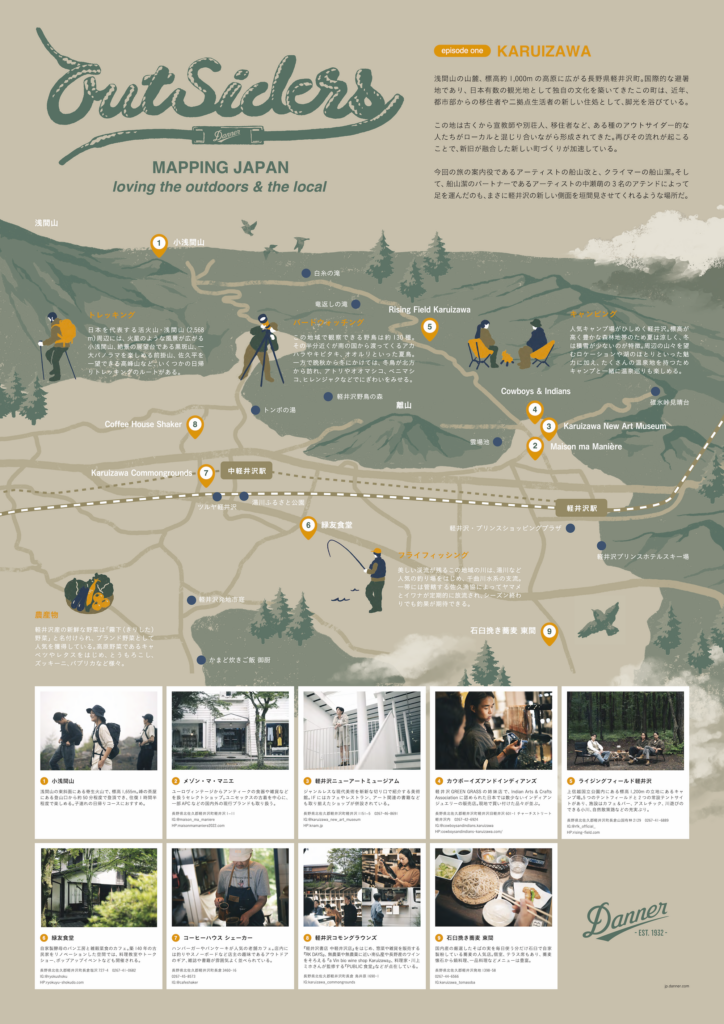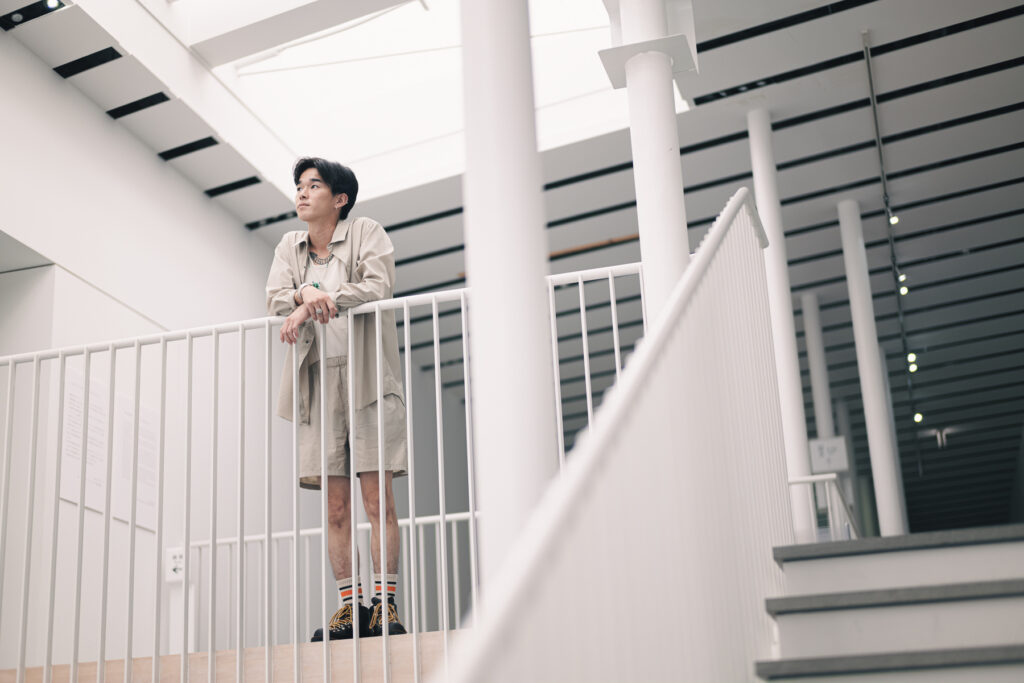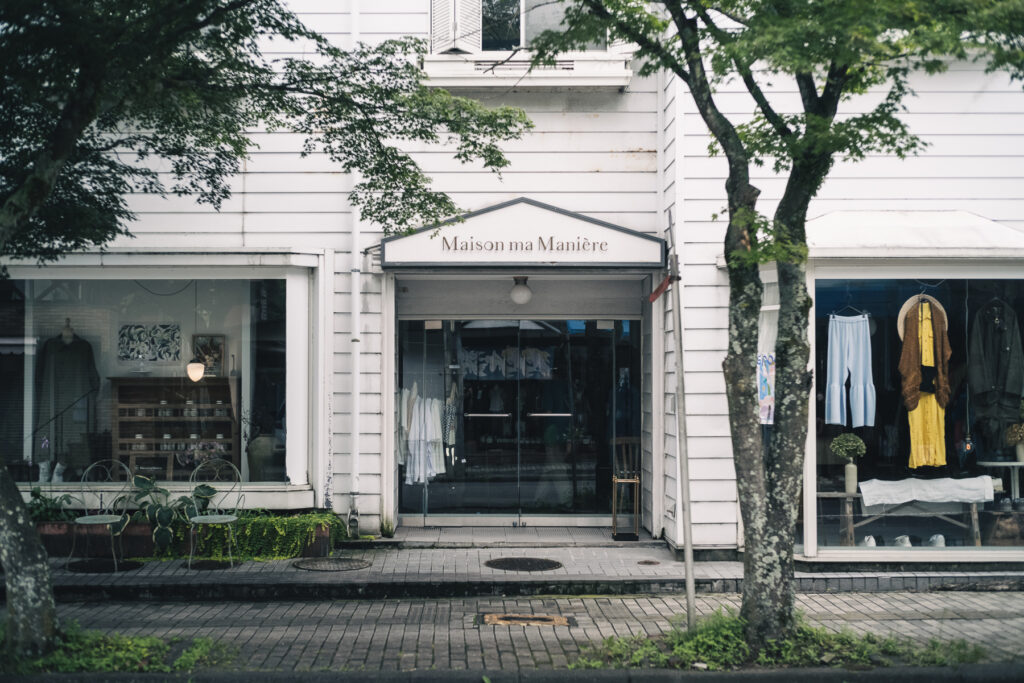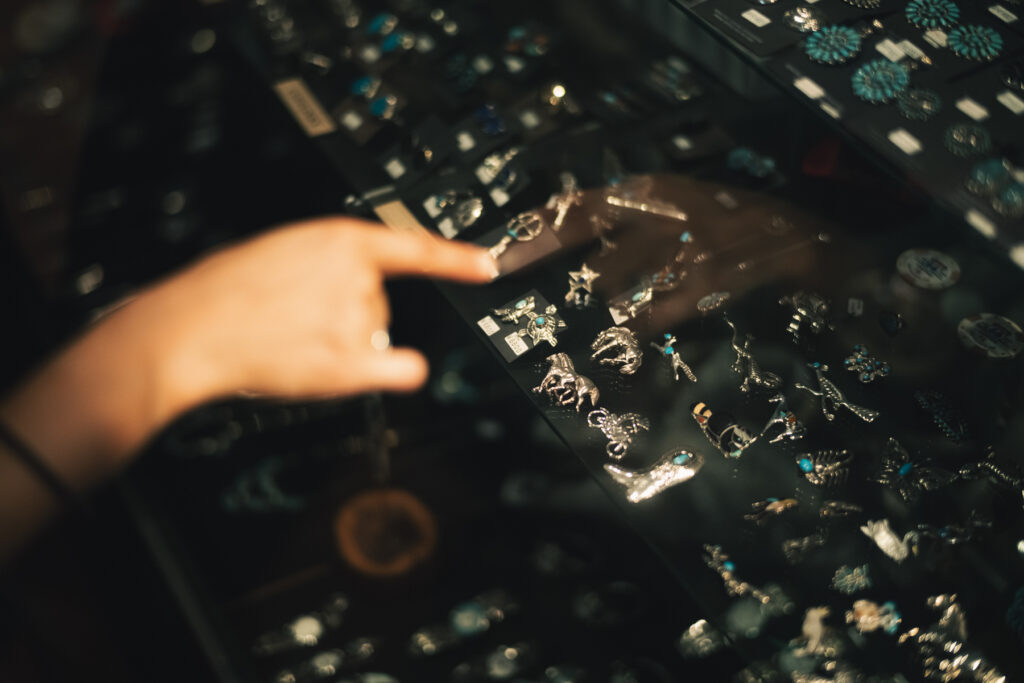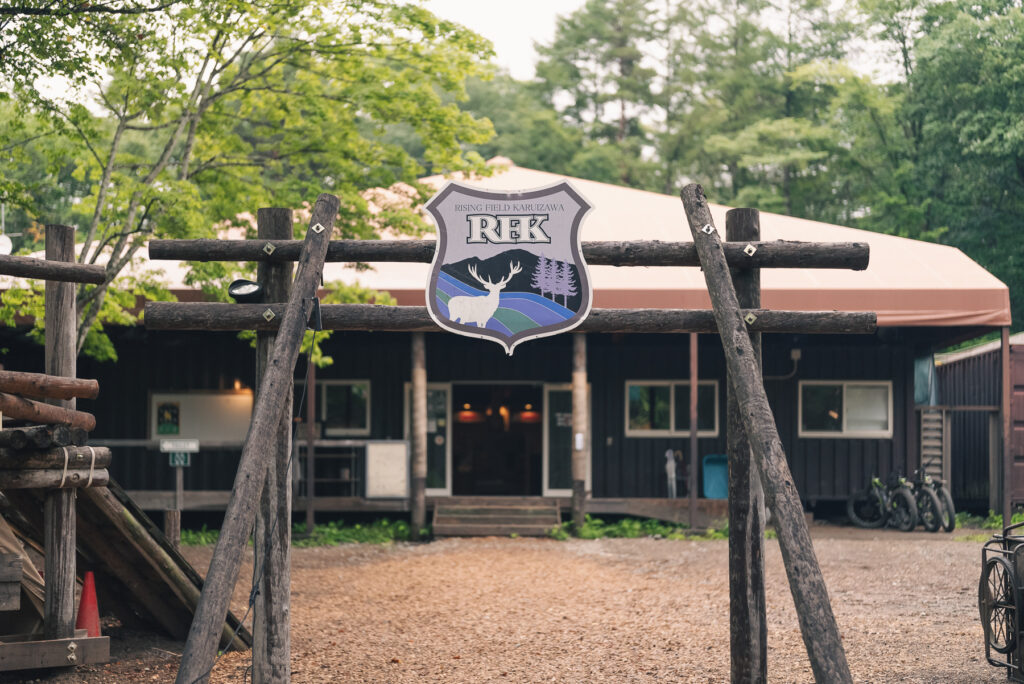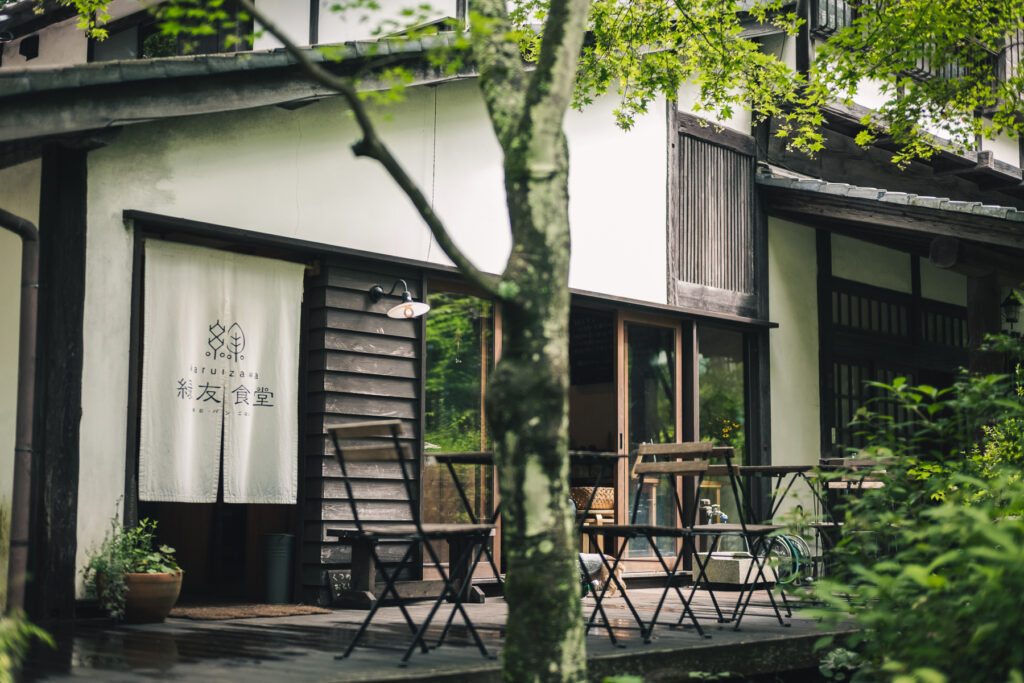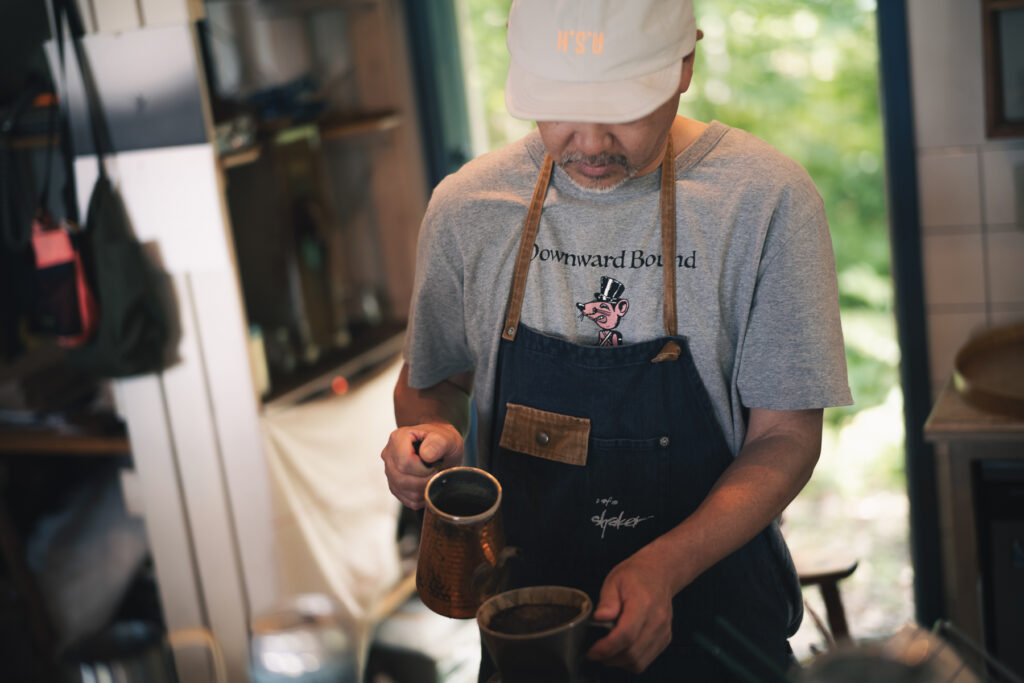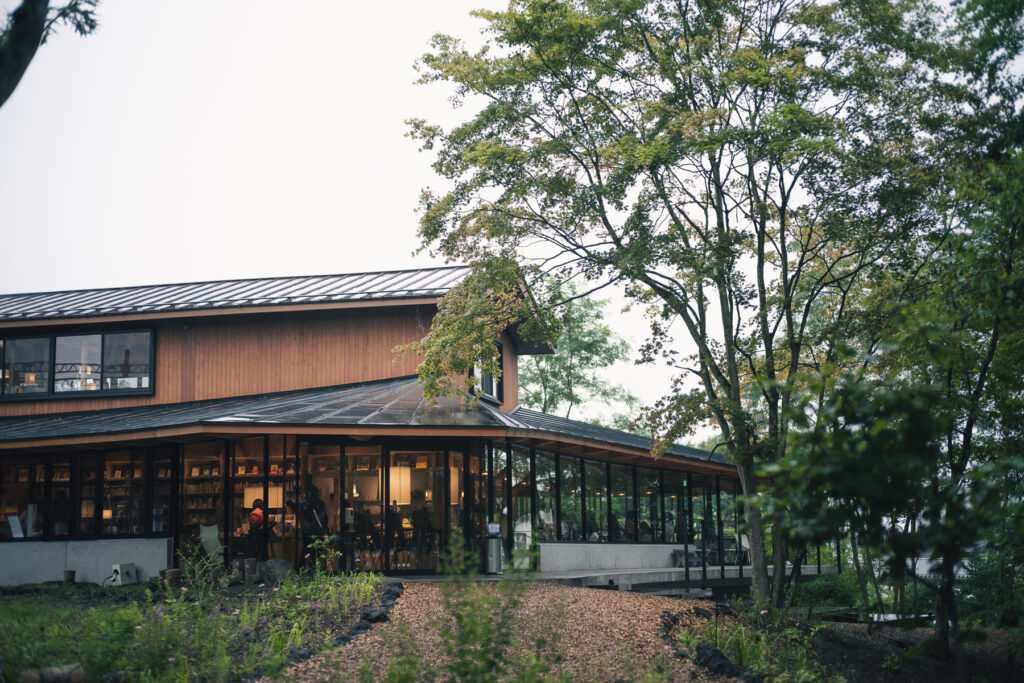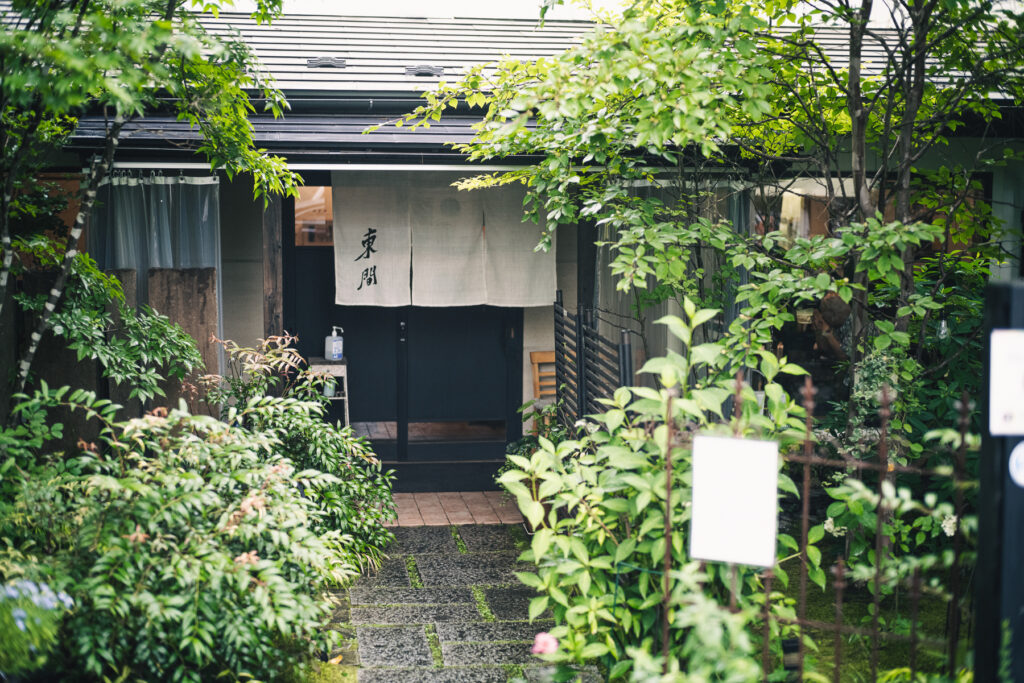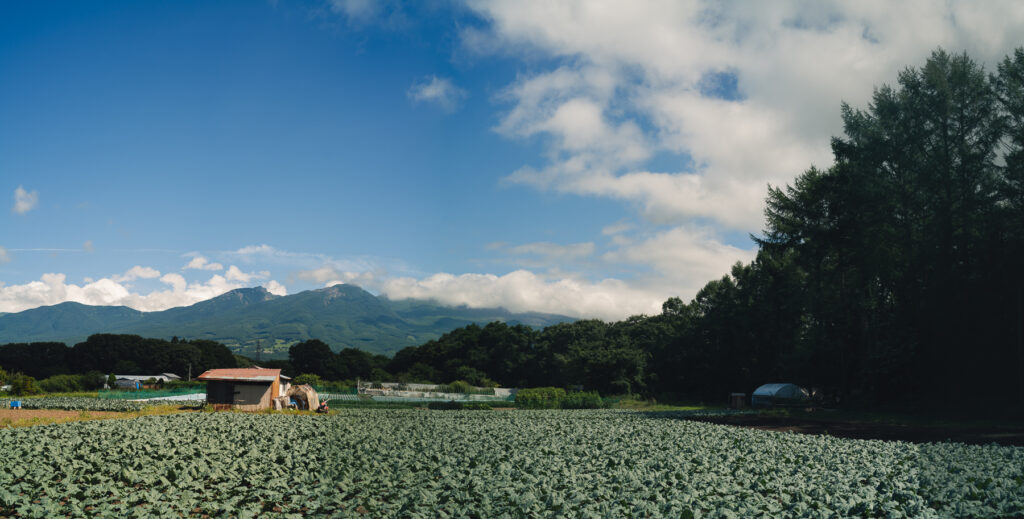
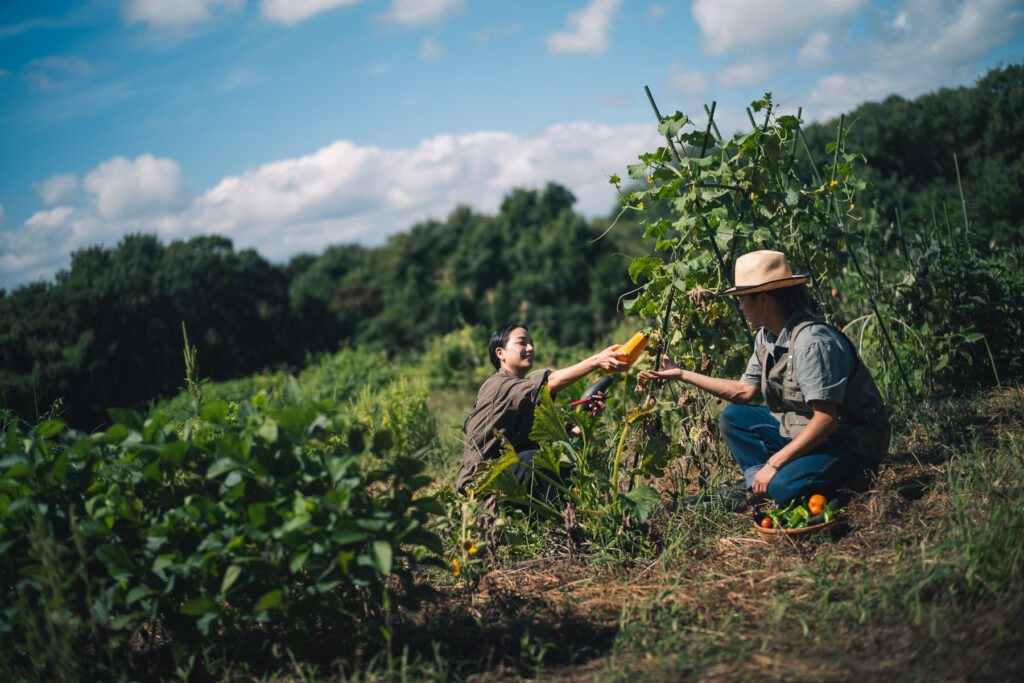
Karuizawa in Nagano Prefecture is situated on a plateau at an altitude of around 1,000 meters at the foot of Mount Asama. The town, which has developed its own culture as an international summer resort and one of Japan’s leading tourist destinations, has recently come into the spotlight as a new home for urban migrants and people living a dual-location lifestyle. The town took shape as missionaries, vacationers, transplants, and other outsiders of one sort or another mixed with the local population over several generations. This trend is happening again and accelerating a new kind of community development that blends the old and the new.
Our guides for this trip were the artist Arata Funayama and the climber Isagi Funayama. We were also joined by Isagi’s partner, the artist Moe Nakase, and the three of them took us to places that afforded us with a glimpse into this new Karuizawa.
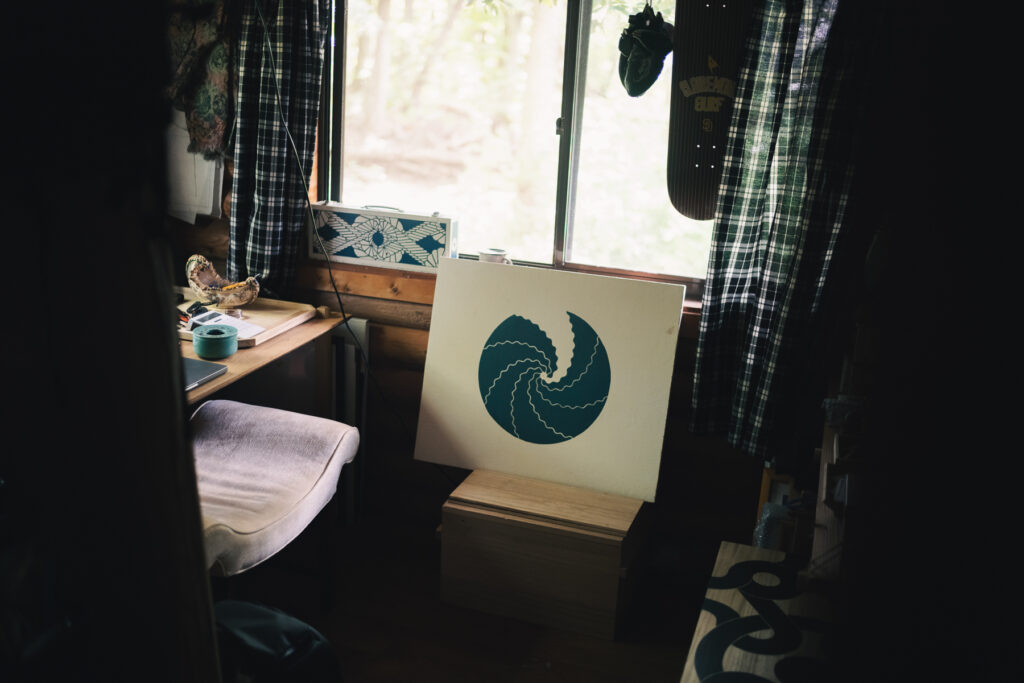
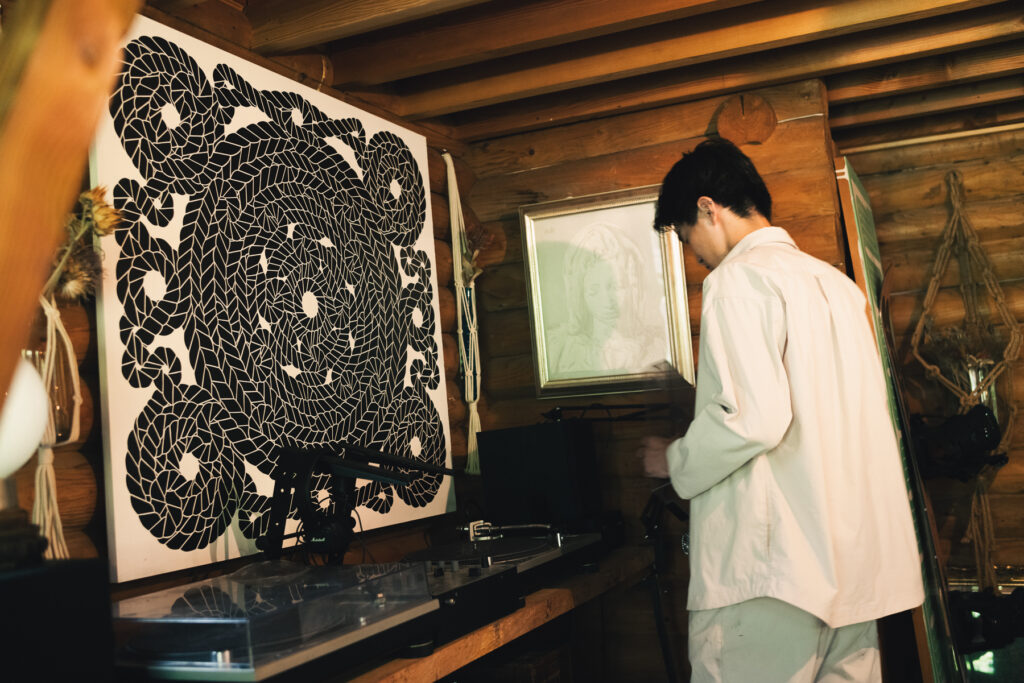
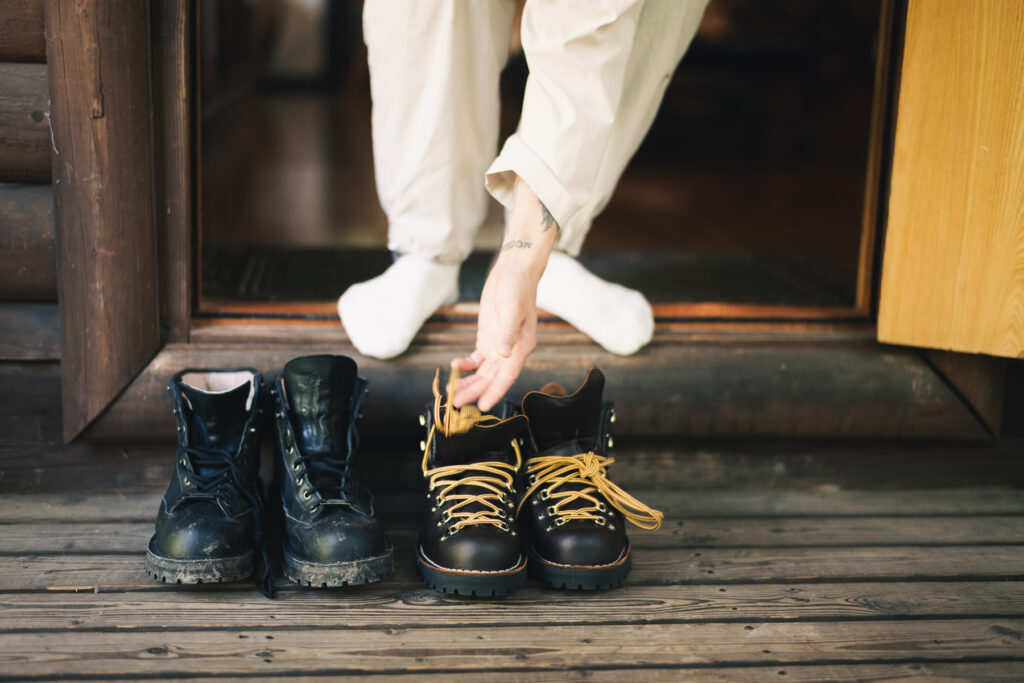
The charm of Karuizawa as seen through its residents’ eyes
“When I was a child, I didn’t really notice how unique the place where we lived was, but now that I am an adult, I have a new appreciation for Karuizawa. I feel that it is a town that can come and go in any direction due to its history as well as the intermingling of foreign and Japanese cultures and the mixture of the urban and the rural. The town and nature are also just the right distance from each other, which allows you to take quick trips out into the field. Karuizawa is a town where you can move freely between contrasting cultures, and this might be what makes it so unique,” says Arata Funayama.
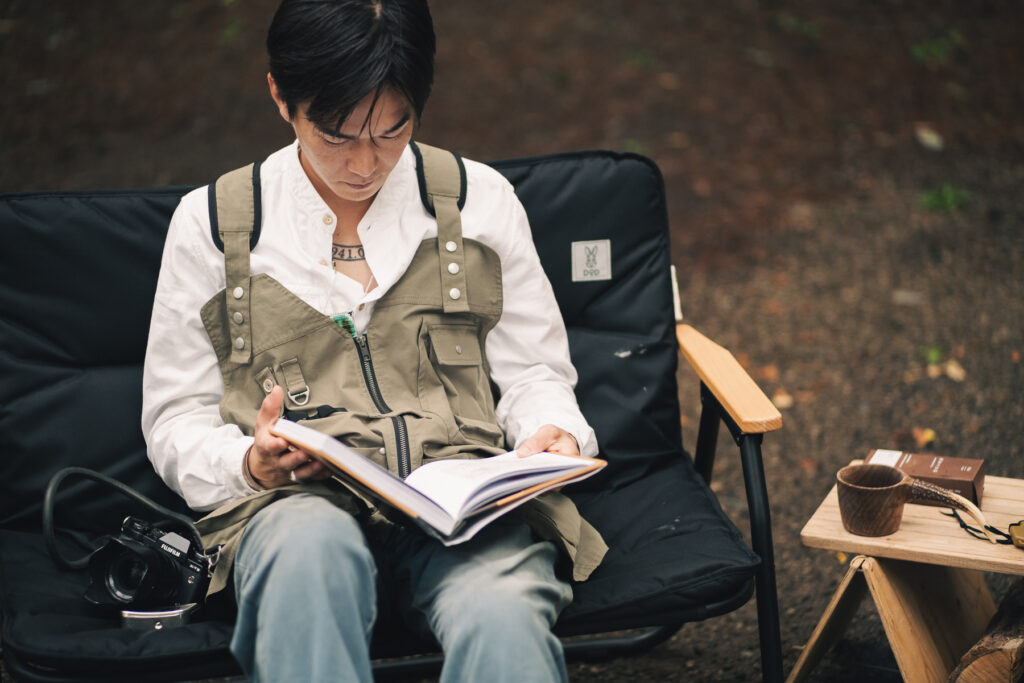
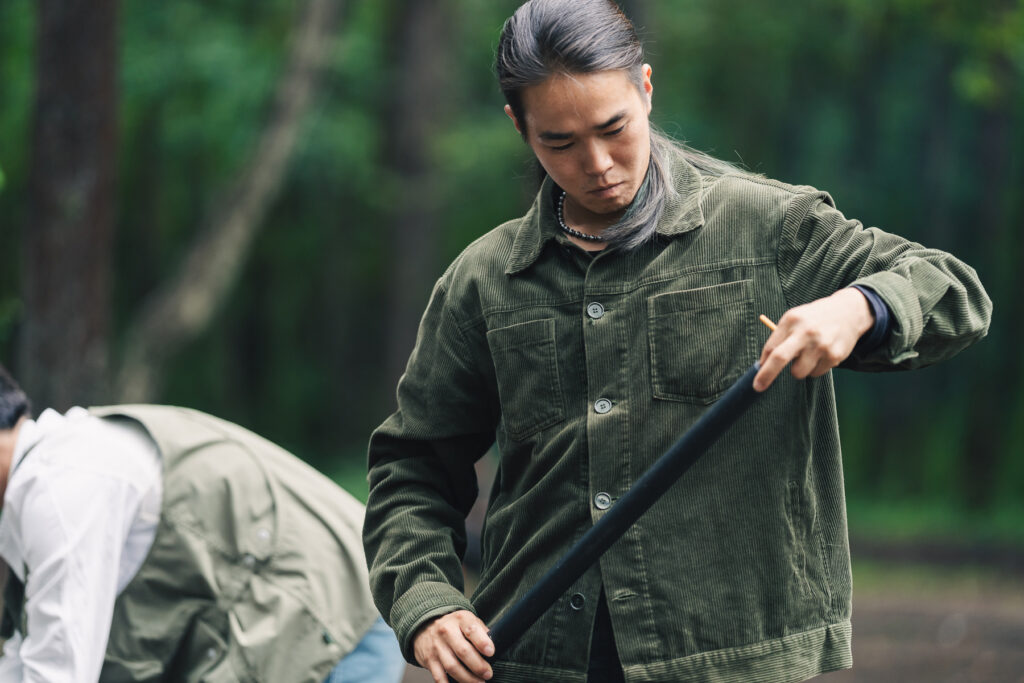
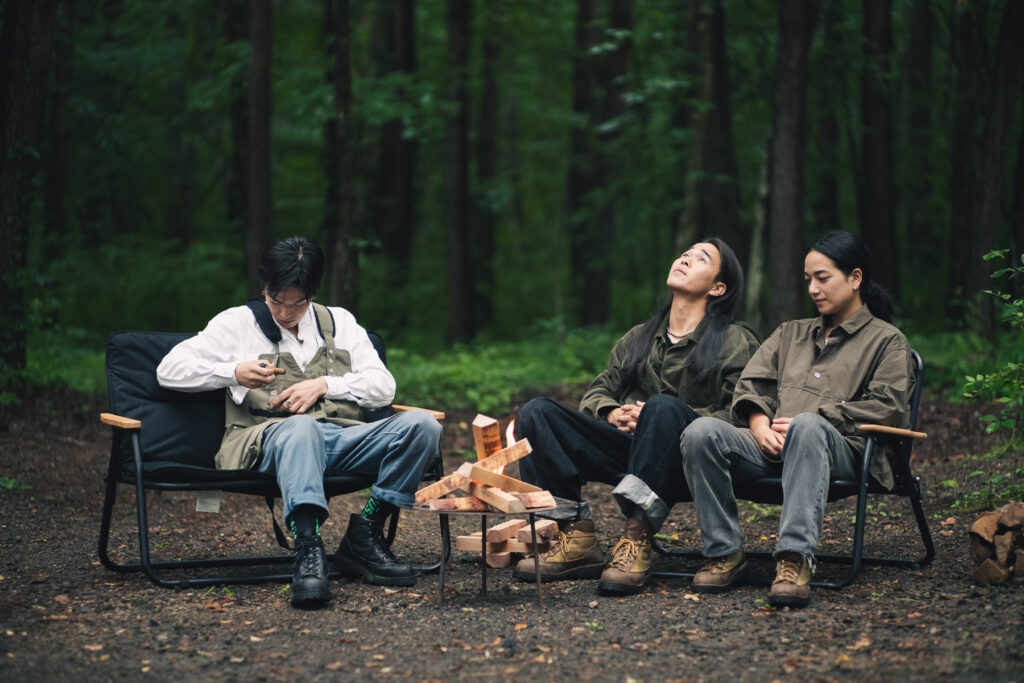
Arata’s brother Isagi, who runs Gen., a guide service that offers a full range of mountain activities in Nagano Prefecture, had this to say about the area’s natural beauty.
“As an outdoor guide, I see the area not as the town of Karuizawa alone, but as the whole area stretching to the foot of Mount Asama, and I think the greatest attraction of the entire region is the richness and variety of nature that has been created by Mount Asama, which is an active volcano. The climate in Karuizawa is cool and misty, and it is surrounded by magical forests. Meanwhile, when you drive down the Asama Sunline in the direction of Miyota and Komoro, there is a moment after only about 10 minutes when the view opens up and the quality of the air instantly changes. In fact, as you approach the vast Sakudaira Basin, there is a higher chance of clear weather. Even though they are neighboring towns, the climate is totally different. Although there are no 3,000-meter-high mountains in the region, there is a unique variety of terrain. With Karuizawa as your base, you can enjoy traveling to nearby areas by car or local train, which also might be something unique to this town.”
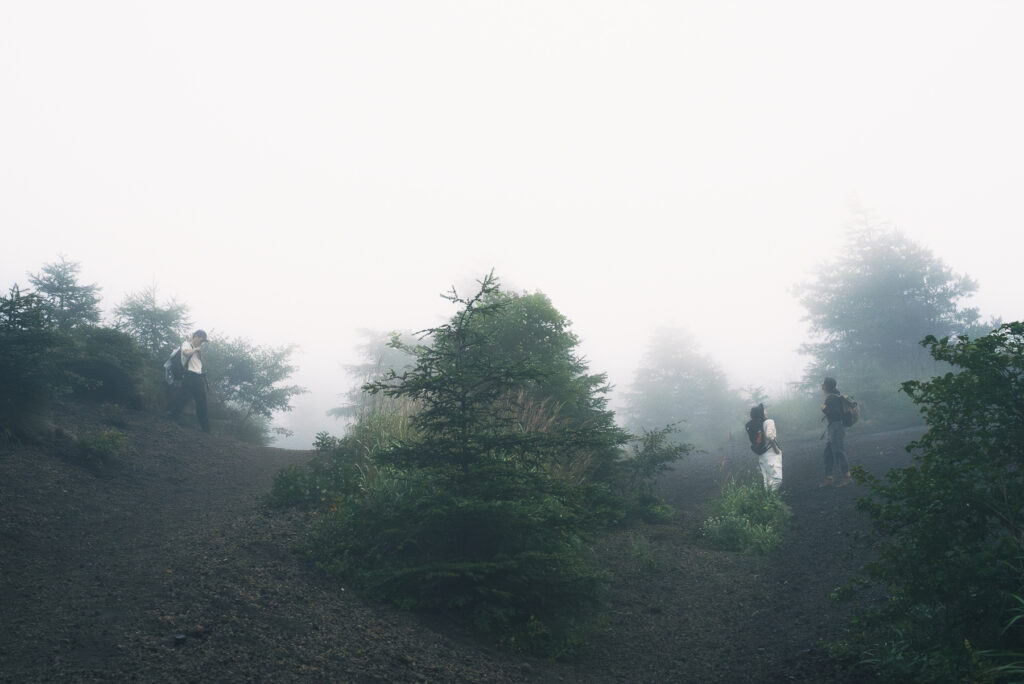
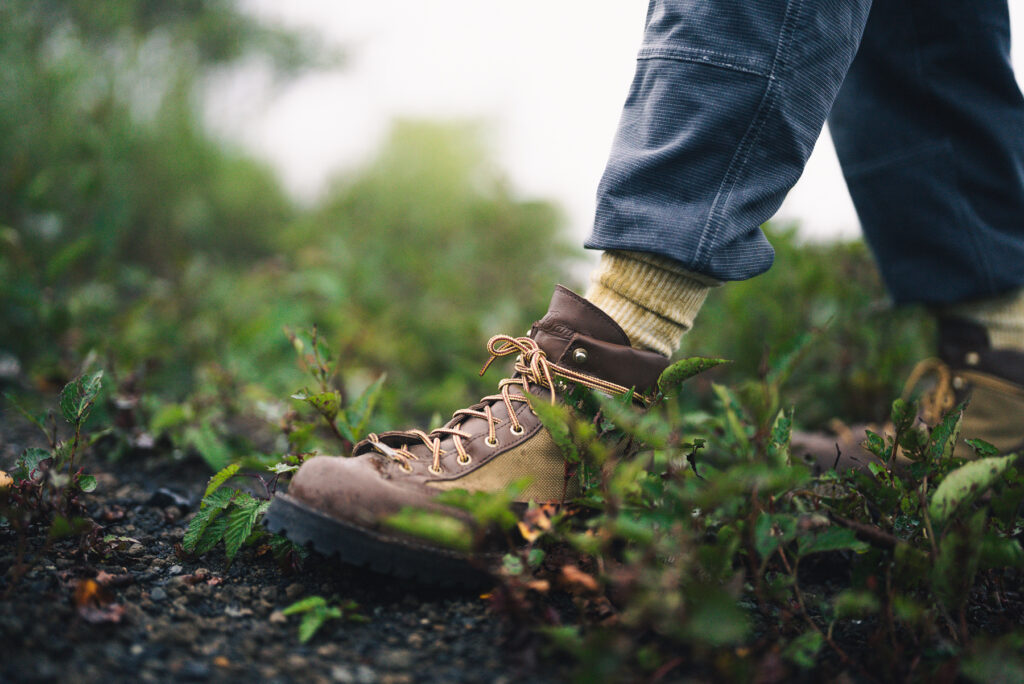
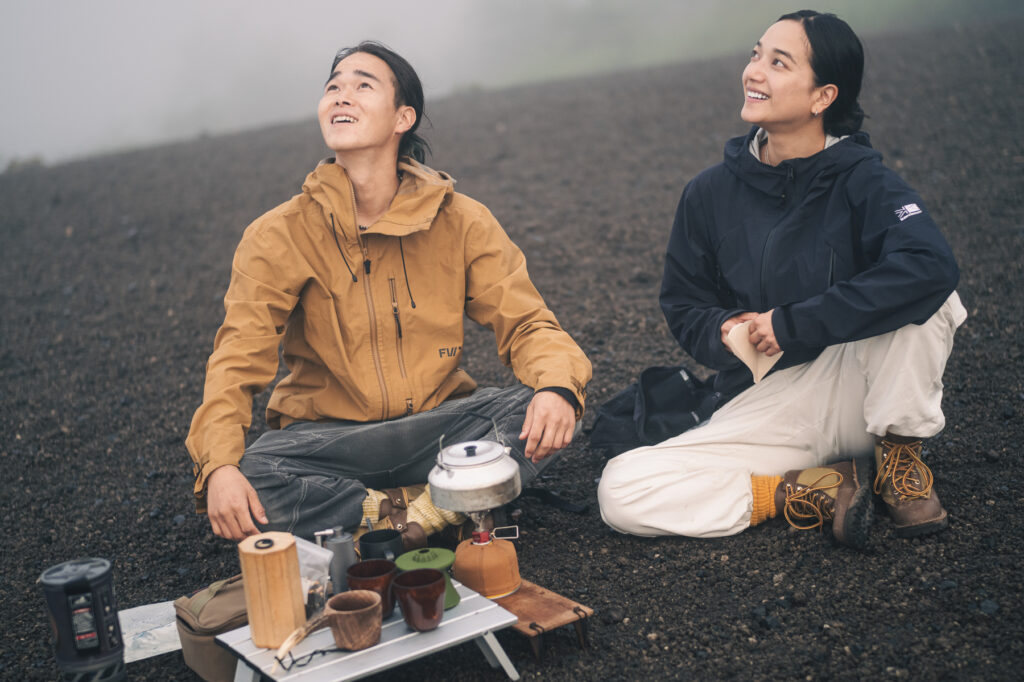
Our other guide on this tour was Moe Nakase, whose background differs from the two brothers who were raised here. Born and raised in Fujino Town, Kanagawa Prefecture, she now splits her time between Fujino and Nagano, and in doing so, says she has come to discover the unique charm of Karuizawa as a place to live.
“In a sense, I think I misunderstood Karuizawa until I lived here. My original impression was that it was a town that catered to rich people coming from the city, so I thought the culture that permeated the area was associated with that. This preconceived notion got in the way, so at first, I didn’t realize the true charm of Karuizawa. It is true that for a small town in a rural area, there are many urban stores here, but it is also a town with different options in all directions depending on your own sensibilities. In other words, I can encounter many different things depending on where I shift my viewpoint. I have come to feel that this inclusivity is very enriching,” says Nakase.
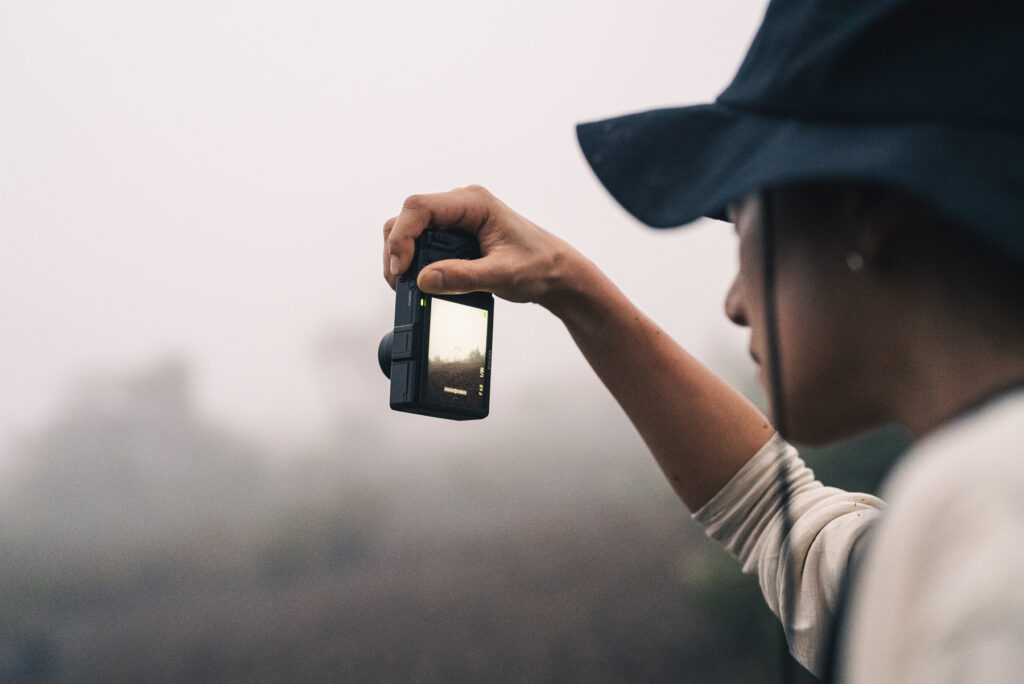
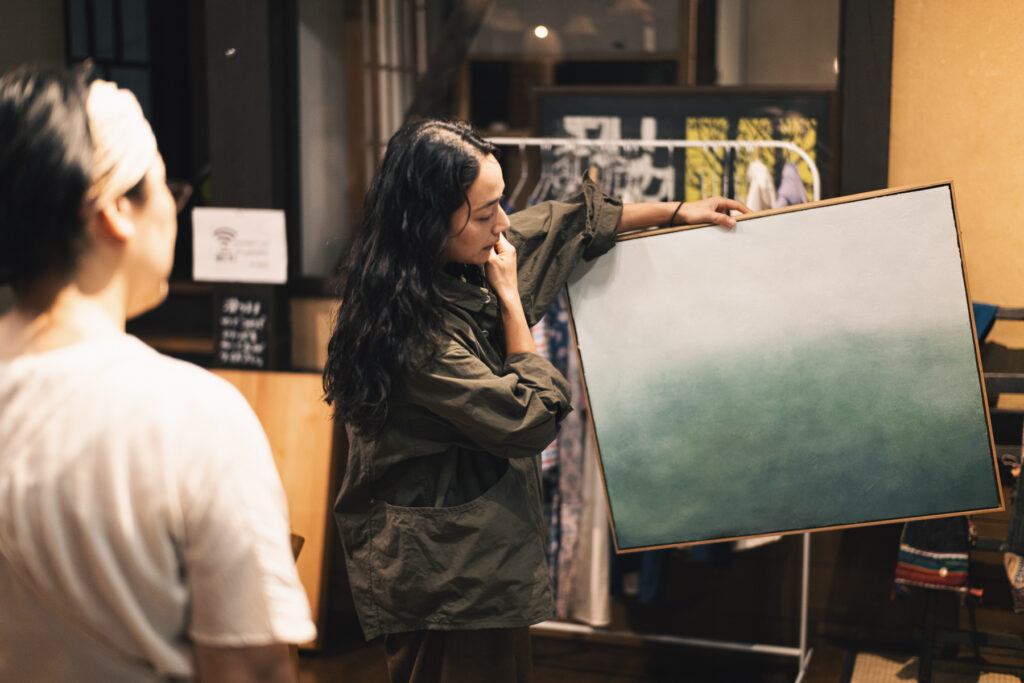
A place where you can enjoy nature alongside art and fashion
We had a pleasant surprise at one of the places we visited on this trip. Susumu Kurosawa, the owner of Coffee House Shaker, greeted us wearing his favorite pair of vintage Danner boots. Kurosawa, a hardcore outdoor enthusiast who likes to fly-fish and snowboard, is uniquely particular about everything from the car he drives to the clothes he wears. He told us that his Danner boots are like a reliable partner that he can wear no matter where he goes.
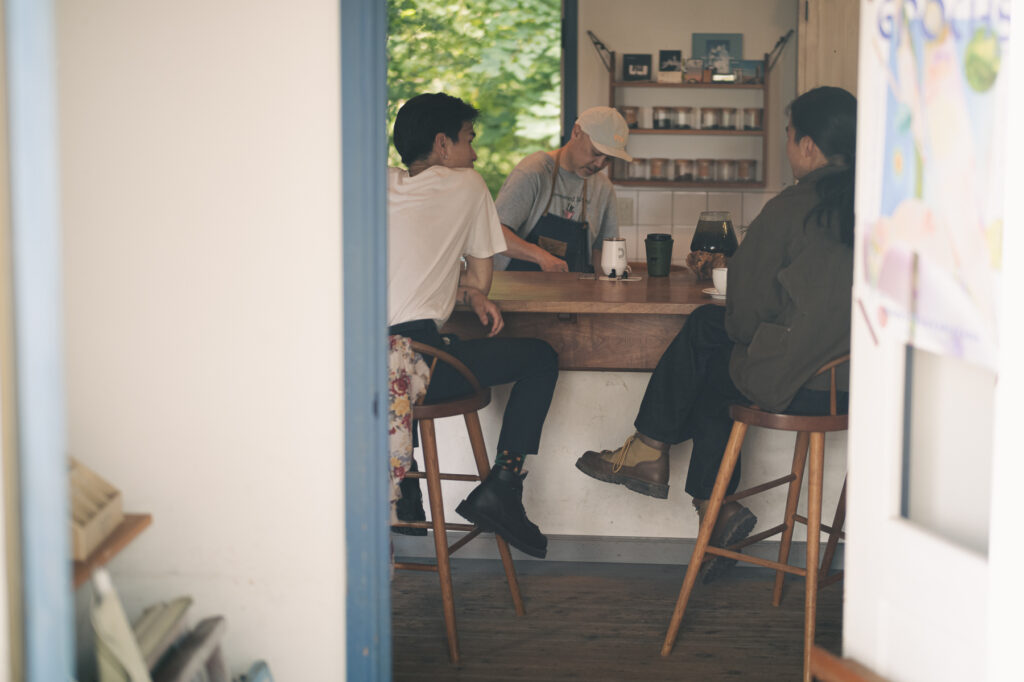
The functionality of Danner boots syncs perfectly with the special qualities of Karuizawa, where you can move seamlessly between art, fashion, and the outdoors. In fact, all three of our guides wore Danner boots everywhere we went, from trekking to camping to just walking around town.
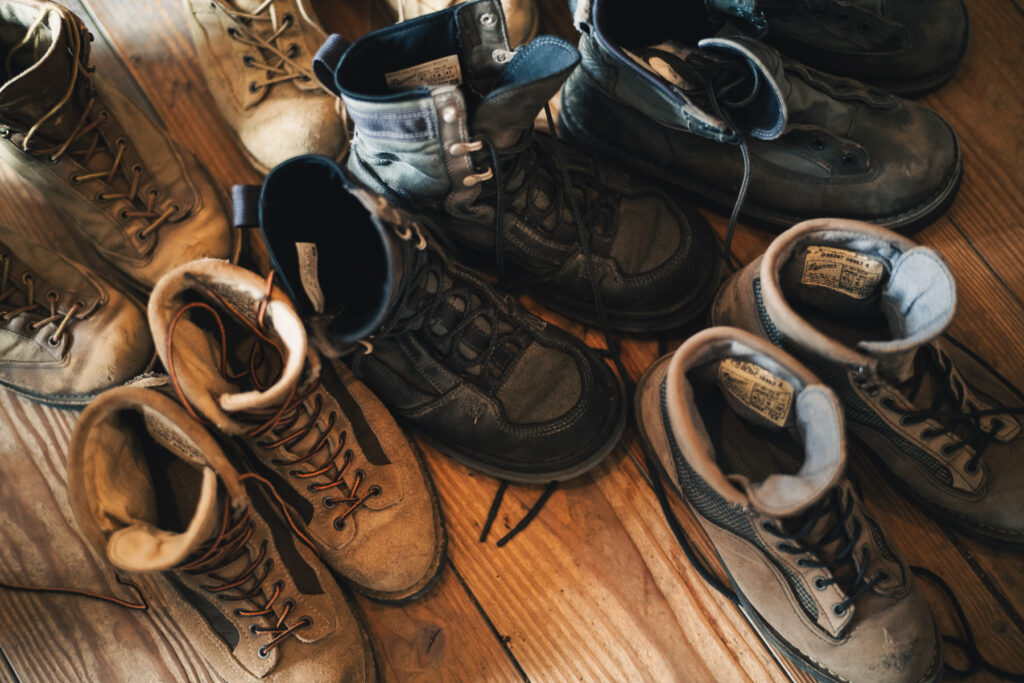
“I had a strong impression that Danner boots were classic trekking shoes, but when I actually tried to coordinate them with other items, I found that they were easy to match with any taste, be it American or European. I realized just how versatile they are as a fashion item,” says Arata Funayama.
“After walking in the mountains, I found them to be excellent boots for outdoor activities in the broadest sense of the word. Especially when you are walking with a heavy load on your back, the sole is just the right hardness to provide stability, so you can walk without having to look at your feet every step of the way. In the past, I think people viewed shoes in terms of their compatibility with a single sport or activity. Danner boots, on the other hand, are all-rounders that you can wear for any activity, and this is what makes them something timeless that you can wear for a long time,” says Isagi Funayama.
“There are three things I value with regard to both my mountain gear and things I use in everyday life. They have to be tough enough to last a long time, simple and understated, and comfortable enough to become like a part of your body. I found Danner appealing because I felt it checked all these boxes. If you get the soles repaired, you can wear them for decades, and the authentic design is both elegant and strong. I think the more I keep wearing them, the more they will become like a companion of mine,” remarks Nakase.
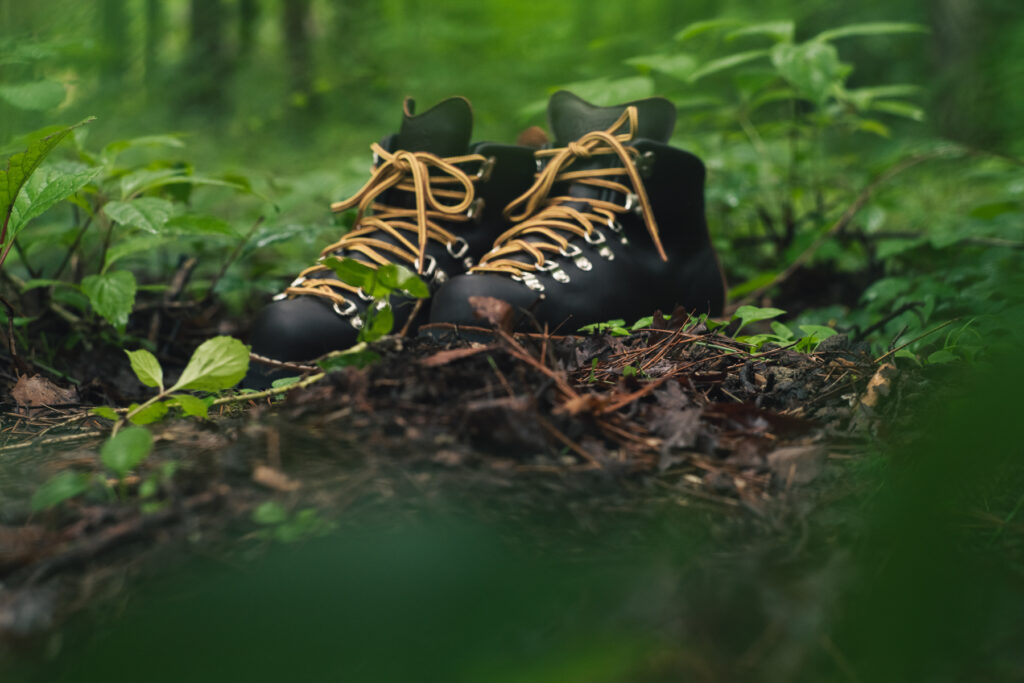
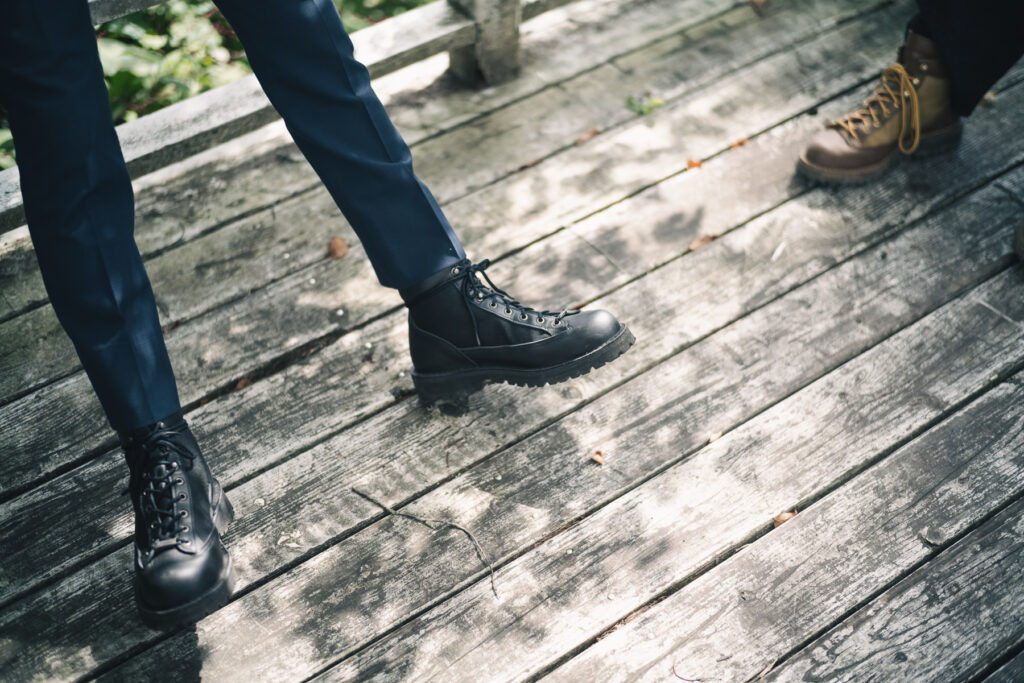
A place where the indoors and outdoors intersect that attracts both tourists and locals alike
The places our guides chose for this trip all had a couple of things in common. First of all, they are all places where both locals and tourists come and go. On top of that, they are places where you can meet the people you want to meet.
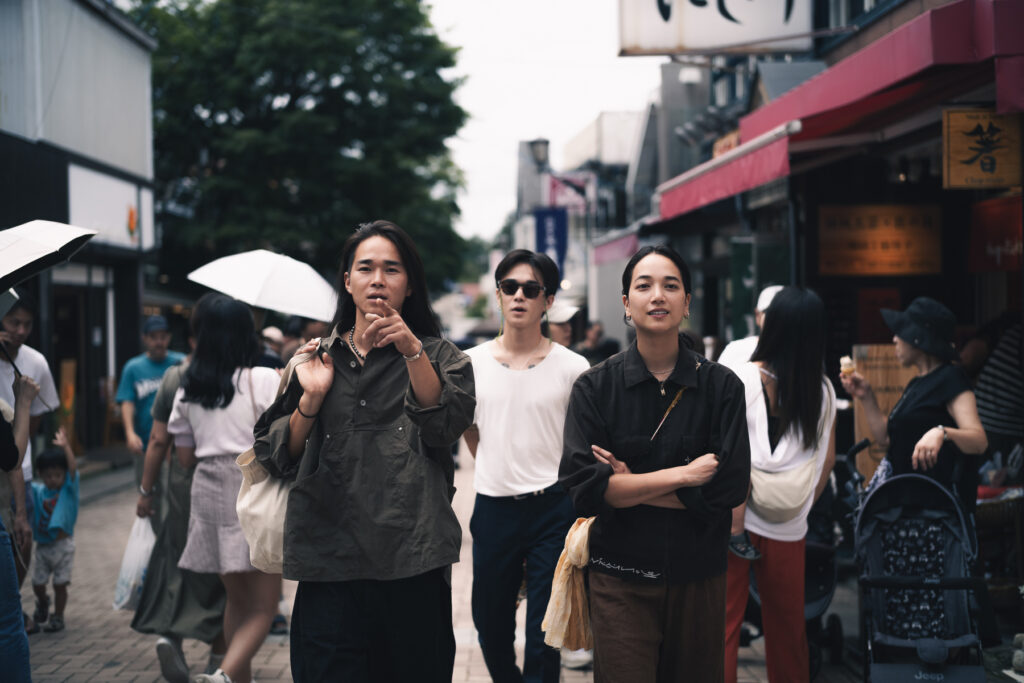
Both Susumu Kurosawa from Coffee House Shaker and Hajime Yamazaki, the owner of Public Shokudo located inside Karuizawa Commongrounds, are core pillars of the local community. Meanwhile, Ryokuyu Shokudo, a combination bakery, which bakes bread with homemade yeast, and vegan cafe, has become a nexus of the local community, with events organized by owner Emi Hasegawa and the people in her network.
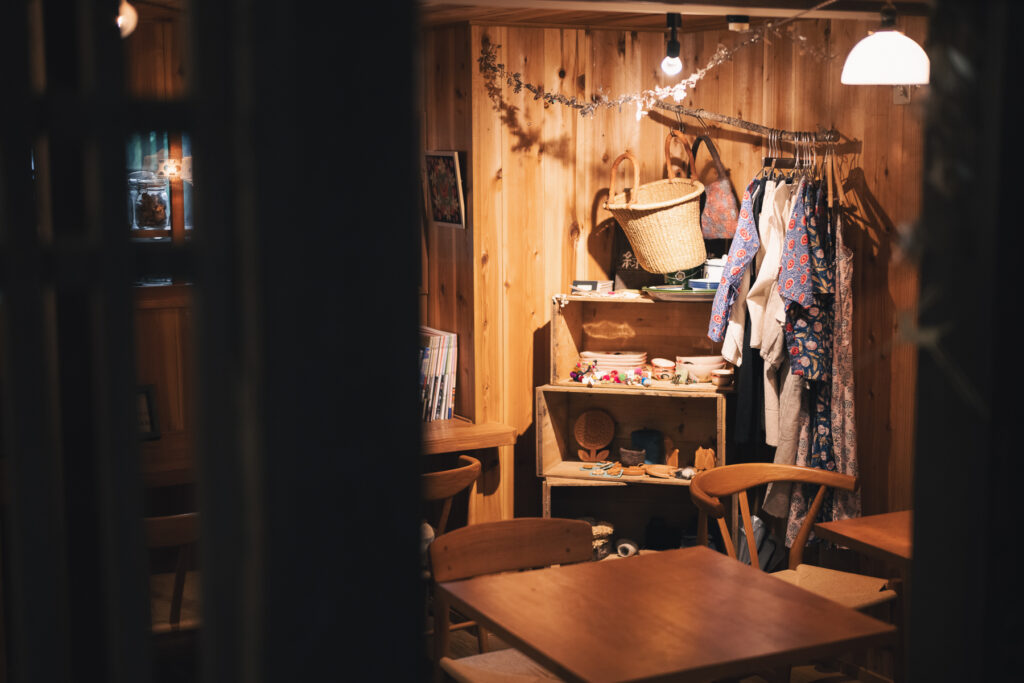
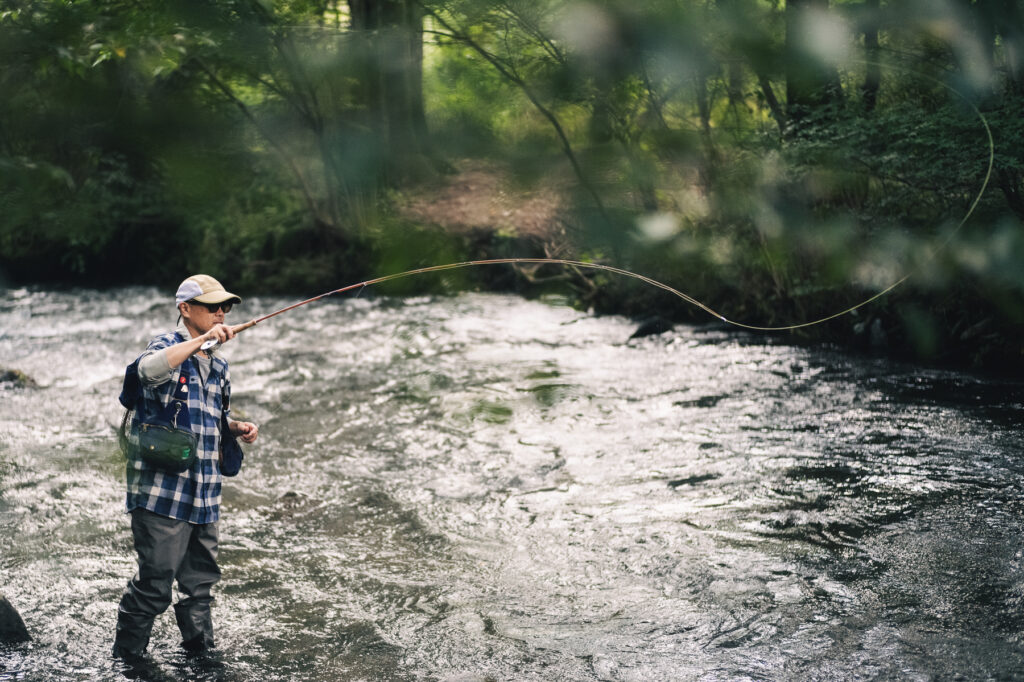
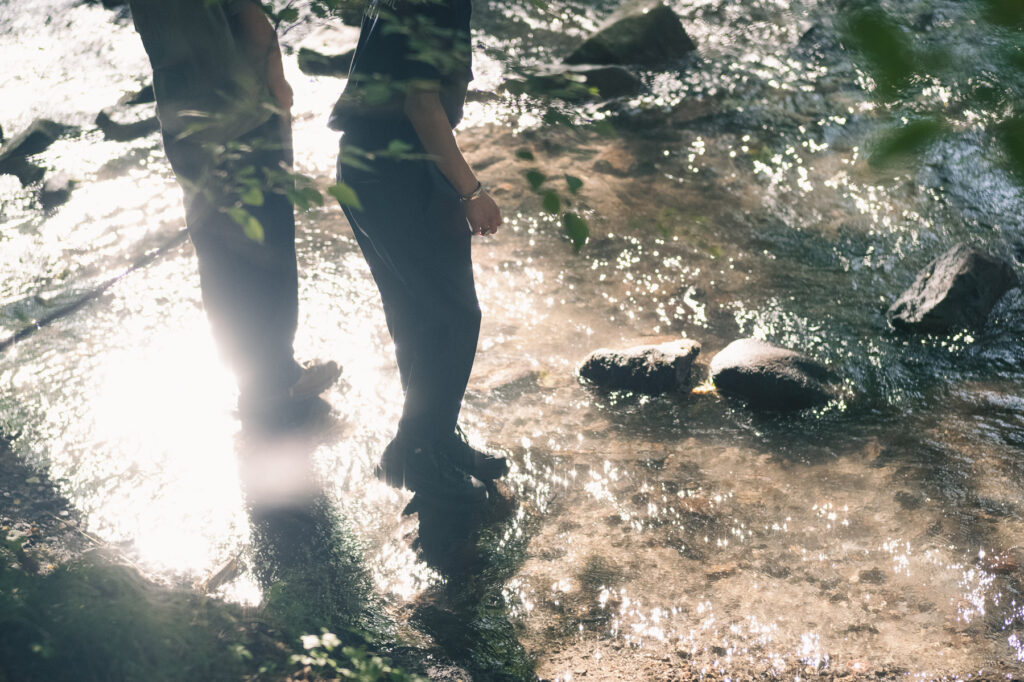
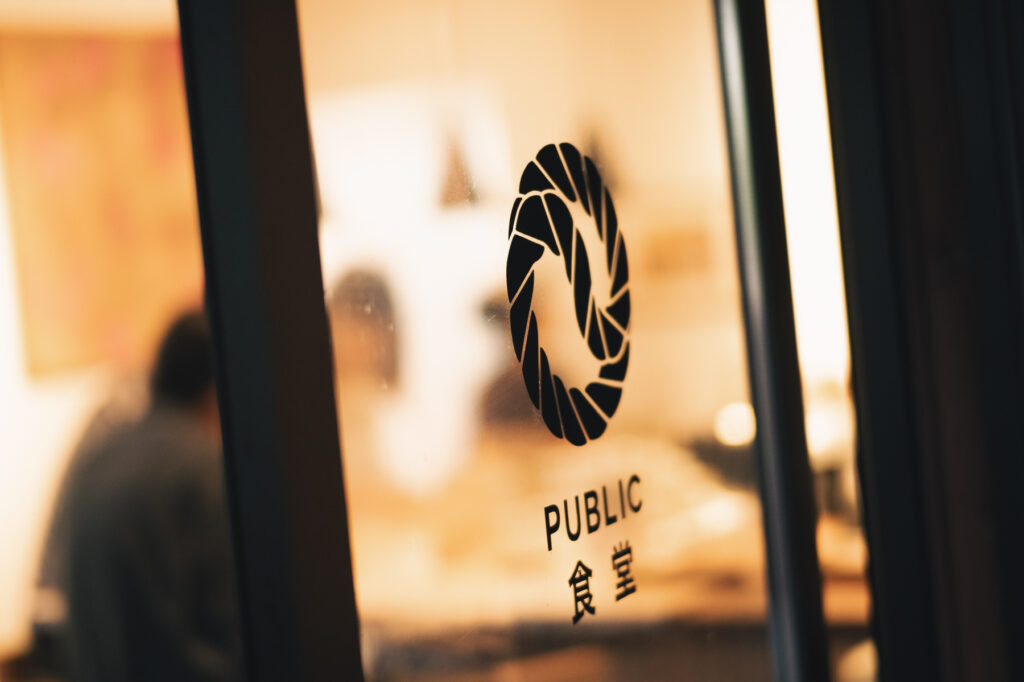
“Of course, we like the comfort and how the food tastes, going to a restaurant also means going to meet the people there. It’s like you’re purchasing something so you can spend time getting a glimpse of the owner’s way of life. This is not something that is limited to Karuizawa, though. No matter where we visit, we go to restaurants and shops to meet people. The people we go to meet are people who are at one with nature; they are neither overbearing nor greedy. When we can interact with people in their element, it allows us to be in our element as well. That’s how I like to spend my time,” explains Isagi Funayama.
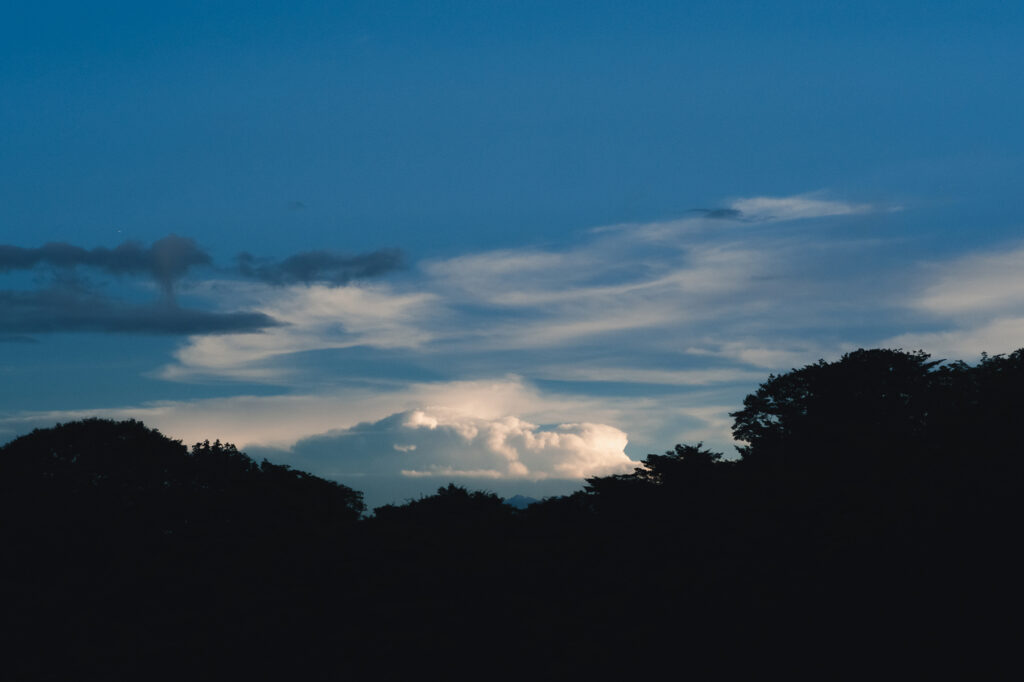
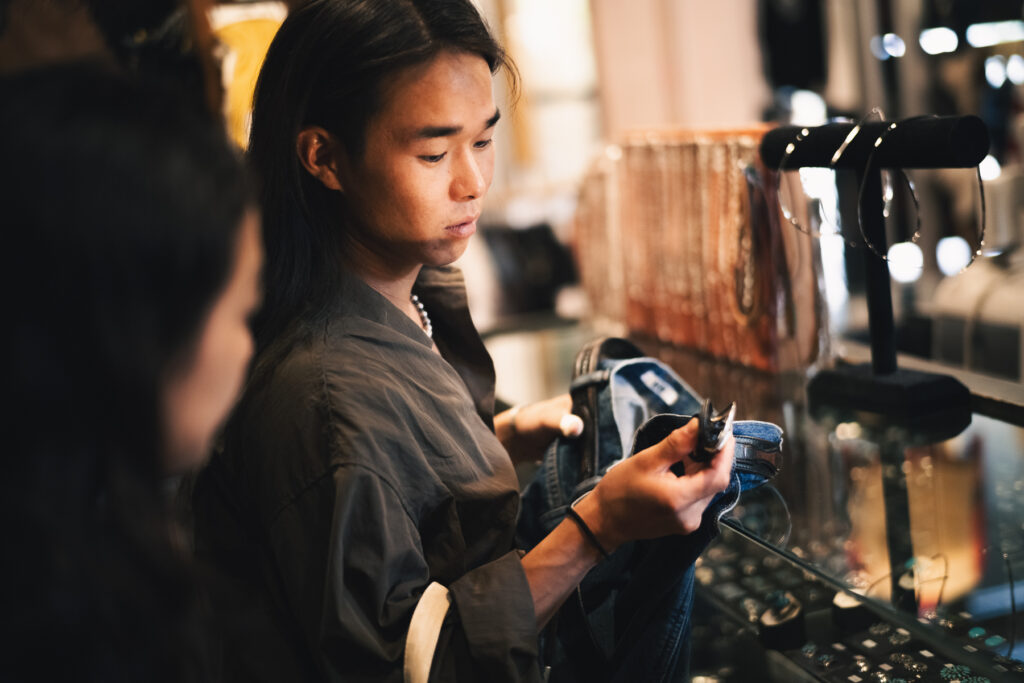
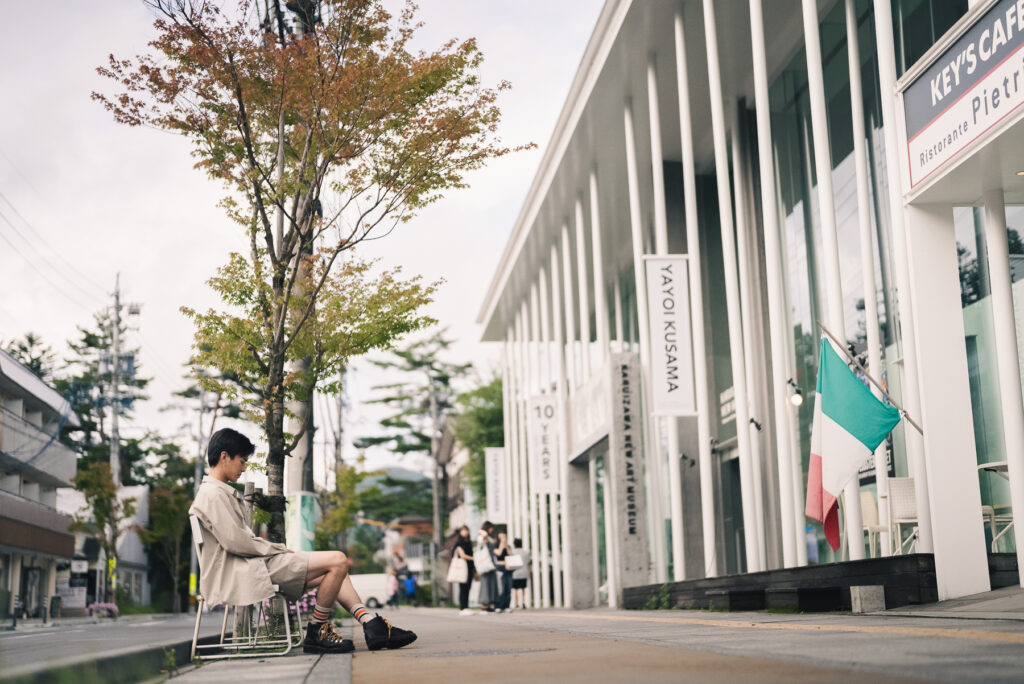
What’s more, the number of stores whose owners or managers are around the same age as our guides is gradually increasing, as is the case with Maison Ma Manière, a vintage and select shop and Toma, a soba restaurant. The Funayama brothers, who have grown up watching local merchants in action, say they feel that “Karuizawa has become a place where local people can start something.” It seems that, little by little, as the next generation takes over the reins, the number of stores that help shape the culture of Karuizawa will keep growing.
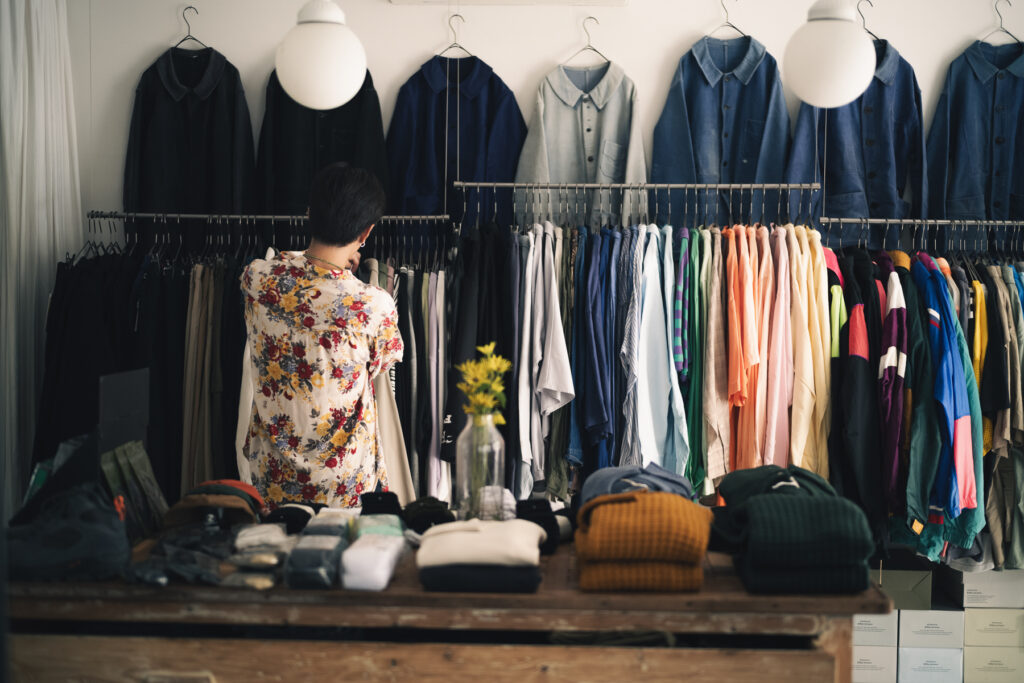
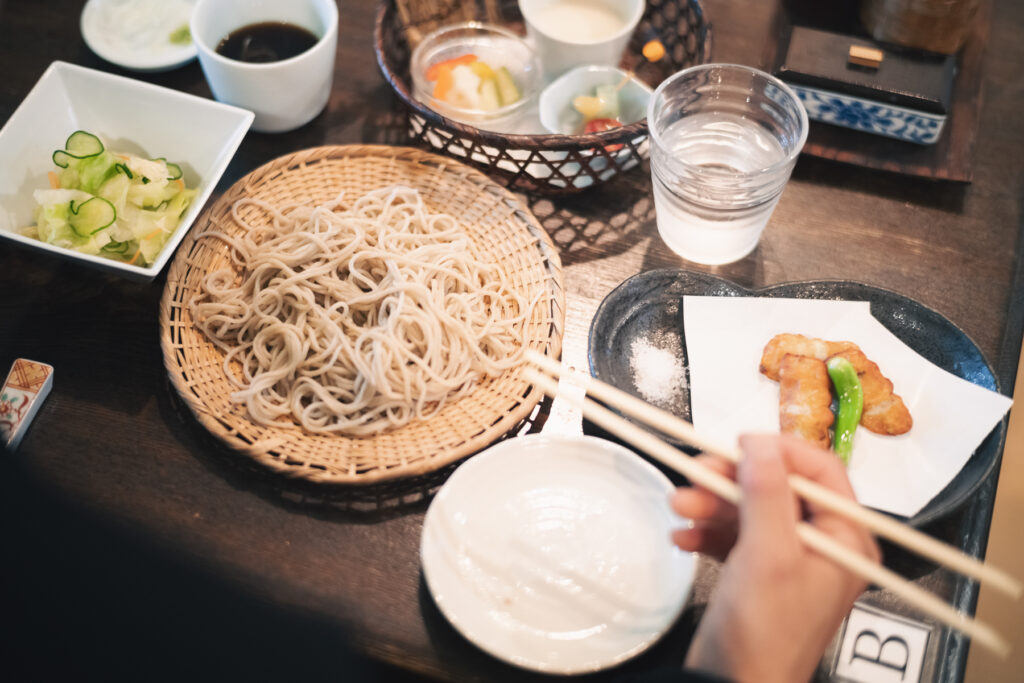
“Shops are the creations of the people who run them, don’t you think? Precisely because many owners place value on nature and the local culture, there are many shops in this town that evoke a sense of harmony with nature, not to mention many buildings and shops that will keep the history of the area alive for posterity. I think discovering these kinds of shops in Karuizawa is as enjoyable as finding interestingly shaped plants and trees in the forest,” comments Arata Funayama.
Karuizawa Guide

Arata Funayama
Artist / photographer. Born in Nagano Prefecture, raised in Karuizawa. After working as a patterner and designer in the fashion world, he now runs his own atelier in Komoro. Focusing on the potential of traditional Japanese crafts and technologies for environmental conservation, in 2021, he began exploring ways to use these to achieve a sustainable society. As part of this endeavor, he serves as the producer for the lifestyle brand “Kiriya,” which focuses on paulownia wood and the town of Mishima, Fukushima Prefecture, and for “Kusabi Karuizawa,” an interior goods brand in Karuizawa, Nagano Prefecture. As a photographer and videographer, he has also taken photos and videos of professional snowboarders, surfers, and other athletes.
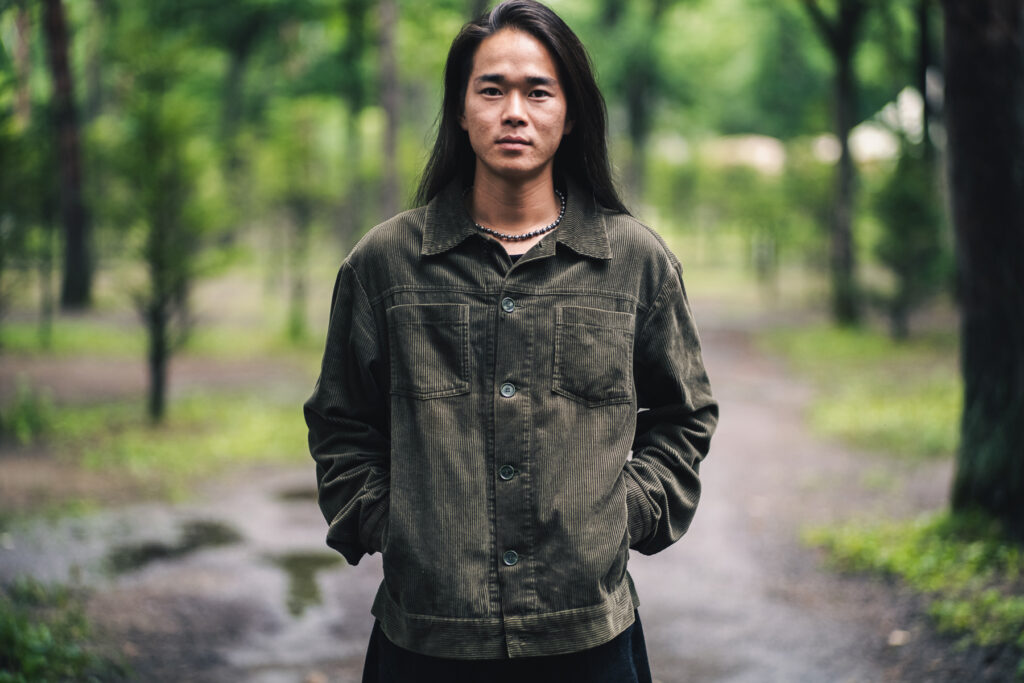
Isagi Funayama
Professional mountaineer; climber and snowboarder. Born in Nagano Prefecture, raised in Karuizawa. After graduating from high school, he traveled to France on his own. Aiming to become an international mountaineering guide, he spent one year training in the French Alps and other challenging mountain environments where he learned advanced mountaineering, alpinism, and backcountry skills. He works in the mountains year round and has extensive experience in extreme environments, including snow and ice climbing. He enjoys rock climbing, mountaineering, backcountry trekking, camping, skateboarding, surfing, and fishing. He currently runs Gen., a concierge guide service that offers options for spending a whole day in nature in and around the mountains of Nagano Prefecture based on client needs. As part of his life’s work, he is involved in a range of environmental activities including self-harvesting forestry to protect the nature he has grown to love while spending time outdoors.
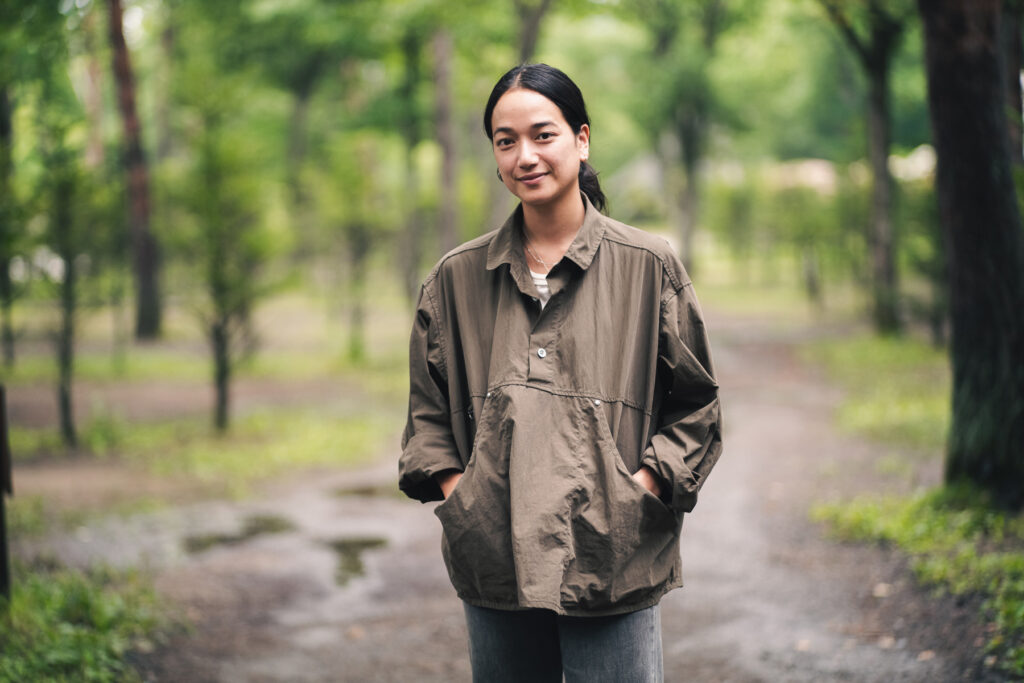
Moe Nakase
Artist. Born and raised in the satoyama of Fujino Town, Kanagawa Prefecture. After teaching herself the technique, she began creating paintings using beeswax in 2014. Based on the theme of “earthly journey,” she abstractly depicts the small changes that she experiences in her mind when he goes into the mountains and the sea as well as the scenes that instantaneously and intuitively transverse her memory when observing the ever-changing natural world. She currently splits her time between Nagano and Fujino, and creates her works while living in harmony with nature.
